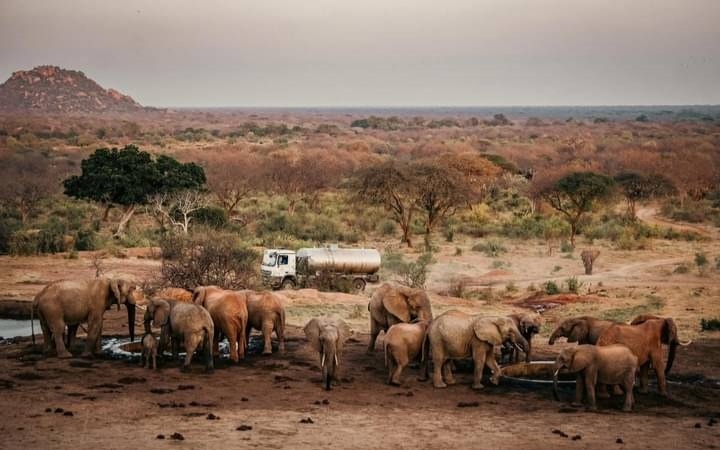Elephants, as far as the eye can see! Ithumba has become a hub for Tsavo’s elephants, particularly during the dry season — but not so long ago, this sight was unimaginable. The reason? Water, or lack thereof. As Kenya’s largest national park, Tsavo is one of the last great wildernesses in Africa and an ideal home for elephants and other creatures. However, its northern sector (Ithumba) is arid and marked by high salinity levels, rendering much of its water undrinkable. When rivers and water pans disappeared during the dry season, elephants had little option but to leave Ithumba. As a result, an otherwise pristine habitat was uninhabited for much of the year.
When we established our Ithumba Reintegration Unit in 2004, we also sought to address the area’s water challenges. In consultation with the KWS, we dug a borehole to tap into water beneath the ground. We also set up a desalination plant nearby, which processes the water and makes it potable. Our water bowsers then distribute clean water to troughs like this one, making several trips throughout the day to ensure drinking sources remain topped up.
As you can see, word is well and clearly out: Elephants young and old come from all over to avail themselves of fresh, clean water. In fact, Ithumba’s water troughs are a resource for all manner of wildlife — just recently, our Keepers reported a pair of buffalos sleeping outside the stockade-adjacent trough, patiently waiting for the next water delivery!
To learn more about Water for Wildlife, our supplementary water project, visit:
sheldrickwildlifetrust.org/projects/water-for-wildlife
When we established our Ithumba Reintegration Unit in 2004, we also sought to address the area’s water challenges. In consultation with the KWS, we dug a borehole to tap into water beneath the ground. We also set up a desalination plant nearby, which processes the water and makes it potable. Our water bowsers then distribute clean water to troughs like this one, making several trips throughout the day to ensure drinking sources remain topped up.
As you can see, word is well and clearly out: Elephants young and old come from all over to avail themselves of fresh, clean water. In fact, Ithumba’s water troughs are a resource for all manner of wildlife — just recently, our Keepers reported a pair of buffalos sleeping outside the stockade-adjacent trough, patiently waiting for the next water delivery!
To learn more about Water for Wildlife, our supplementary water project, visit:
sheldrickwildlifetrust.org/projects/water-for-wildlife
Elephants, as far as the eye can see! Ithumba has become a hub for Tsavo’s elephants, particularly during the dry season — but not so long ago, this sight was unimaginable. The reason? Water, or lack thereof. As Kenya’s largest national park, Tsavo is one of the last great wildernesses in Africa and an ideal home for elephants and other creatures. However, its northern sector (Ithumba) is arid and marked by high salinity levels, rendering much of its water undrinkable. When rivers and water pans disappeared during the dry season, elephants had little option but to leave Ithumba. As a result, an otherwise pristine habitat was uninhabited for much of the year.
When we established our Ithumba Reintegration Unit in 2004, we also sought to address the area’s water challenges. In consultation with the KWS, we dug a borehole to tap into water beneath the ground. We also set up a desalination plant nearby, which processes the water and makes it potable. Our water bowsers then distribute clean water to troughs like this one, making several trips throughout the day to ensure drinking sources remain topped up.
As you can see, word is well and clearly out: Elephants young and old come from all over to avail themselves of fresh, clean water. In fact, Ithumba’s water troughs are a resource for all manner of wildlife — just recently, our Keepers reported a pair of buffalos sleeping outside the stockade-adjacent trough, patiently waiting for the next water delivery!
To learn more about Water for Wildlife, our supplementary water project, visit:
sheldrickwildlifetrust.org/projects/water-for-wildlife



